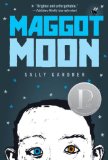Summary | Excerpt | Reading Guide | Reviews | Beyond the Book | Read-Alikes | Genres & Themes | Author Bio

This article relates to Maggot Moon
DYS- (bad, Greek) LEXIA (language, Greek)
A German ophthalmologist named Rudolph Berlin coined the word dyslexia in 1887 to describe patients who, in spite of normal intelligence, had extreme difficulties with reading. Scientific discussion of the phenomenon of what was also called "word blindness" emerged in the late nineteenth century, but the term dyslexia has only become widely accepted in the fields of education and psychology in the last fifty years. It has come to be an umbrella term for a range of problems in the use and decoding of written language, one of the disorders educators have come to call "learning disabilities" along with dysgraphia (writing impairment) and dyscalculia (math impairment).
Dyslexia is known to be a neurological condition – not a disease, but a difference in the way the brain is wired for language. Modern neuroscience has been able to use imaging technology to identify physical differences in the language centers of the brain in children with dyslexia, but the exact physical origins of the disorder are difficult to pinpoint. Some problems may be structural, involving defects in regions of the brain associated with language processing, and some may be functional, meaning that there is a short-circuit in an expected cognitive procedure. Abnormalities in working memory as well as visual processing may be involved. Research into how certain genes may increase the risk of developing dyslexia is being conducted. The brain differences that lead to the disorder are likely to take shape during the early months of fetal development.
While neuroscience grapples with the complex physical origins of dyslexia, in recent years educators have moved forward by leaps and bounds in their understanding of how the disorder manifests itself and how to address it. With early identification and targeted phonics training, many children with dyslexia can become so functional in terms of reading, they can be described as "cured."
Sally Gardner reveals in her biographical note to Maggot Moon that she is dyslexic. She writes, "Dyslexia is like a Rubik's Cube...It takes time to work out how to deal with it, but once you do, it can be the most wonderful gift." The negative images conjured by the medical terms associated with dyslexia (disorder, disability, defect) are at odds with the fact that many dyslexic people come to see their way of perceiving language as a creative difference. Indeed, there is emerging evidence that the dyslexic brain has advantages in certain areas of perception. The impression that dyslexic people have a creative edge may soon have a neurological explanation. Meanwhile, there is a wealth of resources available for people newly diagnosed with dyslexia. There are many adult role models in the public eye, dyslexics like Sally Gardner (along with Whoopi Goldberg, Charles Schwab, James Earl Jones, and Steven Spielberg) who are speaking out about their experiences – both the challenges and the gifts.
Filed under Medicine, Science and Tech
![]() This "beyond the book article" relates to Maggot Moon. It originally ran in March 2013 and has been updated for the
September 2014 paperback edition.
Go to magazine.
This "beyond the book article" relates to Maggot Moon. It originally ran in March 2013 and has been updated for the
September 2014 paperback edition.
Go to magazine.
Your guide toexceptional books
BookBrowse seeks out and recommends the best in contemporary fiction and nonfiction—books that not only engage and entertain but also deepen our understanding of ourselves and the world around us.